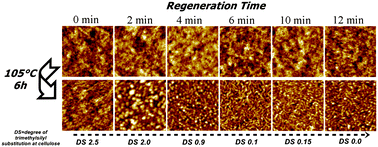Exploring the rearrangement of amorphous cellulose model thin films upon heat treatment†
Abstract
The behavior of

* Corresponding authors
a
Faculty of Mechanical Engineering, Laboratory for Characterization and Processing of Polymers, University of Maribor, Smetanova 17, 2000 Maribor, Slovenia
E-mail:
stefan.spirk@uni-mb.si
Fax: +386 22207996
Tel: +386 22207947
b Karl-Franzens-Universität Graz, Institut für Chemie, Heinrichstraße 28/III, 8010 Graz, Austria
c Jožef Stefan Institute, Jamova 39, SI-1001 Ljubljana, Slovenia
d Humboldt Universität zu Berlin, Institut für Physik, Unter den Linden 6, 10099 Berlin, Germany
e University of Technology Graz, Institute of Solid State Physics, Petersgasse 16, 8010 Graz, Austria
The behavior of

 Please wait while we load your content...
Something went wrong. Try again?
Please wait while we load your content...
Something went wrong. Try again?
T. Mohan, S. Spirk, R. Kargl, A. Doliška, A. Vesel, I. Salzmann, R. Resel, V. Ribitsch and K. Stana-Kleinschek, Soft Matter, 2012, 8, 9807 DOI: 10.1039/C2SM25911G
To request permission to reproduce material from this article, please go to the Copyright Clearance Center request page.
If you are an author contributing to an RSC publication, you do not need to request permission provided correct acknowledgement is given.
If you are the author of this article, you do not need to request permission to reproduce figures and diagrams provided correct acknowledgement is given. If you want to reproduce the whole article in a third-party publication (excluding your thesis/dissertation for which permission is not required) please go to the Copyright Clearance Center request page.
Read more about how to correctly acknowledge RSC content.
 Fetching data from CrossRef.
Fetching data from CrossRef.
This may take some time to load.
Loading related content
